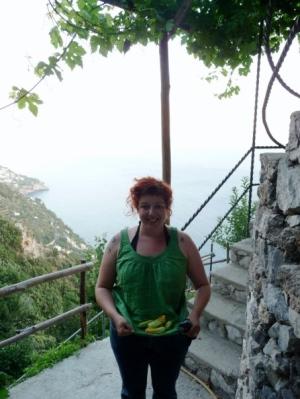This past week I cried. Okay, so crying is not all that uncommon with me since my hormones have been out of whack for the better part of a decade and I seem to be unable to control when the water works come and when they go, appropriate or not. But this most recent cry was not driven by conversation, argument or an overly emotional moment on television accompanied by the swell of music and soft lighting. It happened in a dimly lit queer bar in the Kreuzberg neighbourhood of Berlin called SO36 (after the area’s former postal code) and although there was music, it was certainly not of the Hallmark variety used effectively, and without shame, in the Bell commercials of my youth.
I had planned to tell you all, and in fact had written, a column about our most recent trip — five days in the small Italian village of Nocelle on the Amalfi Coast. We spent time with our lovely gay couple friends from Montreal who were there visiting the only gay in the village (no really, he is the only gay in the village). Earlier this year they had asked us to join them since we were “in the neighbourhood” of Europe, and it was truly magical. There were sunset meals overlooking the Mediterranean, dinner with three generations of a family from the small village where everyone spoke Italian even those of us that don’t know how, harvesting zucchini flowers and capers for a meal so simple and divine it inspired long moments of silence to reflect. Events like these were matched only by small boat rides to near-by beaches for a day in the sun surrounded by people who I am convinced were born with a tan and a trek through the hills on the famous “Walk of the Gods.”
But last night I was reminded not of the big unbelievable things that have made this year a rip-roaring success so far, but of the little things that hit you when you least expect it, that remind you that you are not dead inside despite your ability to charge ahead onto public transit with complete disregard for seniors. And that make you feel things you can’t quite put your finger on but feel better than grilled squid overlooking the sea or Greek hot springs on a summer afternoon.
Like Parkdale, a community with one of the largest Tibetan populations outside of Tibet, West Germany — more specifically Berlin — has a large Turkish community, enough to have the neighbourhoods of Kreuzberg and Neukolln nicknamed Little Istanbul. The culture is vibrant, active and present and their influence since the first wave of immigration in the early ’60s can be seen in everything from grocery stores to clothing shops to open air markets. And on the last Saturday night of every month it can be seen shakin’ on the dance floor of SO36 at “Gayhane” (hane means home in Turkish).
To give my tears some perspective, I have been known to well-up at the sight of old couples dancing on College St during the Taste of Little Italy, or at the sight of a tough urban “dude” sincerely paying his respects at the St Joseph’s Oratory in Montreal, asking for forgiveness and bearing his faith for all to see. So I guess I wasn’t really surprised that the water works made an appearance when surrounded by men and women who donned their Saturday night best for some traditional dance, fancy footwork aplenty.
Our evening started early by our standards at an ungodly 9pm. Forewarned that the lineups could be extensive, we went to the bar to get stamped and thought we would duck out to a fave watering hole nearby to wait it out until the party really got started. What we found when we arrived was a dance class teaching those interested in learning a traditional Turkish or Kurdish folk dance, and an enthusiastic invitation to join in. Figuring there was little to no chance that kind of offer would ever be extended again, we jumped at the chance and an hour later, after learning a grapevine-like step, felt ready to take whatever Gayhane could dish out. But first, our favourite watering hole to “limber up.”
After meeting up with a Toronto pal in town for a few days we headed back to the bar for the main event, hours of endless dancing. True to the rumours, the bar was packed. The crowd ranged in age from late teens to late fifties and beyond the beauty of an intergeneration crowd, on it’s own enough to make a gal teary, there was a sense of abandon that filled the room. Hundreds of queers celebrating community and culture, shared experience and an understanding of history. Once the initial waves of awe and appreciation passed I was able to join in with my newly found dance knowledge and somewhat sloppy moves.
Like any night worth its salt, there was a lovely hostess and a belly-dancing show by “Susan” who was capable of isolating parts of her body inch by inch and drove the crowd wild. Hoots and hollers could be heard over the pounding beat of Turkish dance music and after her stellar performance it was back to the party. As I was leaving the stage area I heard my very own siren call, Hava Nagila. Loud. Over a dance beat. In Berlin. At a queer bar. And people cheered. And danced. And cheered some more. And maybe some of us cried a little.

 Why you can trust Xtra
Why you can trust Xtra


